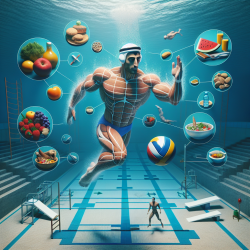Introduction
In the realm of aquatic sports, the distinct physiological and nutritional demands of athletes are paramount to achieving peak performance. A recent study titled "Body Composition and Dietary Intake Profiles of Elite Iranian Swimmers and Water Polo Athletes" provides valuable insights into these demands. This research emphasizes the importance of tailored nutritional strategies to enhance athletic performance in swimming and water polo, two sports with unique energy and nutrient requirements.
Key Findings
The study involved 10 elite swimmers and 13 water polo athletes, assessing their body composition and dietary intake. Notably, water polo athletes exhibited greater height, body mass index (BMI), fat-free mass, skeletal muscle mass, and overall weight compared to swimmers. Conversely, swimmers consumed significantly higher daily energy, carbohydrates, proteins, and fats, reflecting their intensive training regimens.
These findings underscore the necessity for differentiated nutritional interventions tailored to the specific demands of each sport. Swimmers' higher caloric intake aligns with their rigorous training, while water polo athletes' greater muscle mass supports their strength and agility needs.
Practical Implications for Practitioners
For practitioners working with aquatic athletes, understanding these distinctions is crucial. Here are some practical applications:
- Customized Nutrition Plans: Develop nutrition plans that cater to the specific energy and macronutrient needs of swimmers and water polo players. Swimmers may require higher carbohydrate intake to fuel endurance, while water polo athletes might benefit from protein-rich diets to support muscle mass.
- Regular Monitoring: Continuously assess athletes' body composition and nutritional status to ensure they are meeting their performance goals. This can help identify potential deficiencies and adjust dietary plans accordingly.
- Position-Specific Strategies: Consider the unique demands of different positions within water polo, as players may require varied nutritional support based on their roles.
Encouraging Further Research
While this study provides valuable insights, it also highlights the need for further research. Future studies should explore the impact of specific training phases, such as tapering, on dietary intake and performance. Additionally, investigating the role of micronutrients in aquatic sports could offer deeper understanding of optimal nutrition strategies.
For practitioners, staying informed about the latest research and continuously adapting strategies based on emerging evidence is essential for optimizing athlete performance.
To read the original research paper, please follow this link: Body Composition and Dietary Intake Profiles of Elite Iranian Swimmers and Water Polo Athletes.










